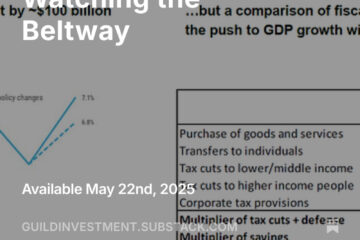The current investment environment suggests one critical lesson to us: the future into which we are moving is going to be very different from the immediate past. Therefore, investment strategies which have become standard-issue conventional wisdom over the past few decades are going to fail. Investors will have to reach further back in history to identify the economic epochs with critical lessons relevant to the current landscape. Those who do not have the personal or institutional memory to do so, or who do not seek out advisors with such memory may be unable to adapt.
Fortunately, since Guild has been focused on both macro and individual company research since the late 60s, we do have such an institutional memory. Here are a few important points we see on the deeper past of which younger investors might not be aware. Even larger, long-established firms might not be willing or able to act on these insights, since their models tend to be rigid and unadaptive. The current historic market environment is not one that will reward rigidity.
Indexing and 60/40 Portfolios
One piece of conventional wisdom that has become almost universal is the 60/40 stock/bond portfolio, which has recently been subjected to closer examination. Such a “balanced portfolio” allegedly provides broad asset-class diversification, less volatility, and better returns for the risk taken. It has performed well recently. But if we take a wider historical view, the 60/40 portfolio has had many “lost decades” — extended periods of flat performance. (And of course, in inflation-adjusted terms, those periods have been a lot worse than just flat.)

Source: GMO Capital
These “lost decades” have a lot to do with the supposed lack of correlation between stocks and bonds. In truth, in a longer historical view, there is no such correlation — or rather, it is sometimes positive and sometimes negative. Therefore to pursue an asset allocation strategy that is good for all conditions may be a fool’s errand — and to believe that any asset allocation can simply be set on autopilot forever has historically proven to be dangerous.
The Missing Piece: Commodities
Our more perceptive readers studying the chart above will note substantial overlap in the 60/40 “lost decades” with periods during which gold and other precious metals performed strongly. This brings us to the topic at hand: commodities.
Inflation expectations are rising (as we have been chronicling for months). Under these conditions, in the initial phases of an inflationary period, equities tend to perform well, since inflation expectations in the beginning signal an anticipated period of economic acceleration and expansion. However, once inflation expectations reach the point at which they trigger the fear of higher rates, they are not as good for equities — particularly for many equities which sell at elevated P/E ratios, and consequently see those P/E ratios contract as future rate increases are priced in.
Note that this is the very scenario which can see both asset classes of a 60/40 portfolio falling in price — often, not a scenario foreseen by a conventionally minded investment advisor.
The missing piece is commodities. Commodities, in general, are more resilient in the face of tightening, depending as they do more on current supply/demand dynamics than on anticipated interest rate hikes. Therefore, in the difficult mid-phase of an inflationary period, when both stocks and bonds can be challenged by the anticipation and implementation of rate hikes, commodities can shine — both gold, and other commodities. This is especially true when rates are rising and the yield curve is steepening, i.e., when shorter-term rates are rising more slowly than longer-term rates. That looks very much like the environment that we are entering. As we have said before, the Fed has more control over short-term than long-term interest rates for many technical reasons.

Source: Goldman Sachs Economic Research
What Kind of Inflation Is Coming?
Commodities are the great hedge for the inflation which will be coming for the next couple of years. We do not believe that this inflation will lead to a “Great Reset”; it won’t be that strong (remember that there are still many disinflationary forces at work in the world, both demographic and technological, pulling against the inflationary forces). We may see 3–4% inflation in the Consumer Price Index (CPI).
Note that we are not calling a top on equities. We are still in the early stages of a developing inflationary impulse. As we noted above, this early stage can be good for equities. But the shift, when it comes, can be both rapid and uncomfortable, so investors would be well advised to begin repositioning now.
Investment implications: Commodities can be an inflation hedge both in the short run and in the long run. Mild inflation will benefit those commodities which are in short supply and needed for industrial activity. Copper has had a big run; it may be late in the cycle for copper and iron ore, but silver, rare earths, lithium, materials, natural gas, and food grains — as well as gold, platinum and palladium — can benefit. Steel will likely be challenged by China’s efforts to put long-term downward pressure on the domestic Chinese steel price; they are the world’s biggest producer. Iron ore may peak soon. Some growth stocks and suppliers to commodity producers will do well once interest rates begin to rise; but the primary area which will do well before and after interest rates begin to rise will be commodities themselves. Investors should not rely on an auto-pilot asset allocation strategy. Now is the time to review and reconsider commodity exposure as a critical portfolio component for coming years.


